VETERANS or the Union Army, returning to their home towns in New England or the Middle Atlantic states after the war were surprised at what they saw. They had grown up in towns where most of the people lived by farming, while the rest sold things to farmers or worked in local workshops. Perhaps a mill and a factory had stood on the bank of the town’s river. The farms, stores and workshops remained, but now there were many new brick buildings used for factories, mills and warehouses.
American industry, concentrated in the river valleys and ocean ports of the northeast, had grown with a rush during the Civil War. Behind the fighting lines, factories had turned out rails and telegraph wires, rifles and bullets, boots, uniforms, blankets, tents — all the articles needed for the Union forces. These products of Northern industry made a big difference on the battlefields.
Before the war, the South had been an agricultural land, with large plantations worked by slaves and smaller farms worked by poor white farmers. Cotton was the big crop and great quantities of it were sold, especially to the mills of Great Britain. The wealth of the South, based on the unpaid labour of slaves, had given it as much influence within the nation as the North, which was partly agricultural and partly industrial. The South had little industry. When war came, it was unable to keep its fighting men supplied with weapons and other needs. The ill-equipped Southerners were worn down by the well-equipped Northerners, until finally they were completely defeated.
The victory of the Union upset the balance of power between the North and the South. With the freeing of the slaves, most of the Southern planters were ruined, while the leaders of industry in the North were stronger than ever. They included manufacturers, bankers, financiers, company promoters and owners of the railways which now criss-crossed the Northeast and stretched out over the flat and rolling farmlands of the Middle West.
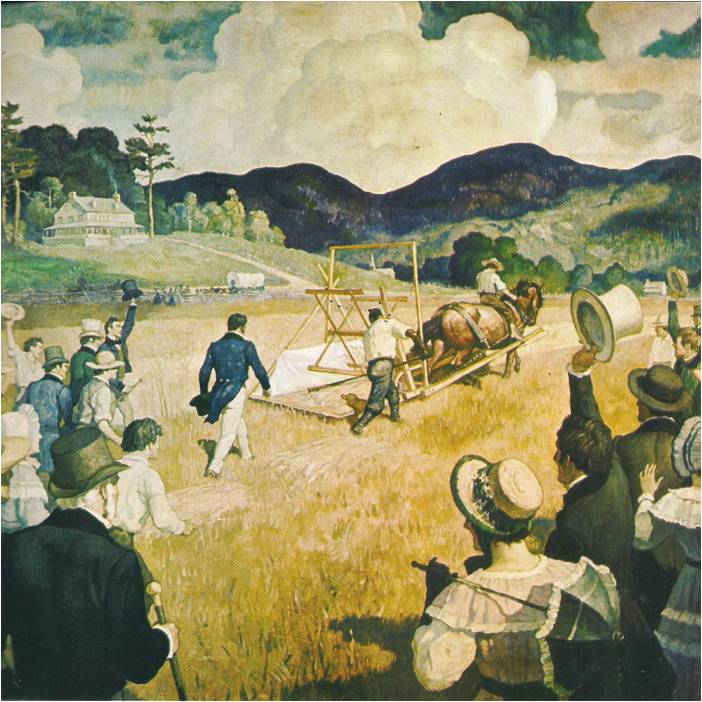
Wealth and their control of industry and transportation made these men the most powerful in America. They dominated a dozen or more states, through lawmakers and government officials who did their bidding and often they dominated the national government itself. They and the big businessmen who came after them were to play commanding roles in politics, setting government policy and picking men to fill high positions in government, throughout the next half-century of swift industrial growth.
In Boston, New York, Philadelphia, and other centres of industry, the end of the Civil War brought government orders to a sudden stop. Factory wheels slowed down. Soon, however, they were spinning as fast as ever, for the nation once more united, needed their products in peace as it had in war. Farmers needed plows‚ wagons and farm tools; miners needed spades and pickaxes; carpenters needed saws, hammers and nails — and so on through all the trades and professions. Almost everybody wanted inexpensive factory-made clothes in the latest fashion, as well as furniture, crockery, glassware, cutlery and hardware.
SETTLERS AND IMMIGRANTS
As the country developed, so did its needs. New devices like the McCormick reaper, the sewing machine and the typewriter were eagerly bought up when they came on sale. To turn out the goods people wanted, manufacturers had to have more and better machines. So industry kept growing, slowly changing the lives of all Americans.
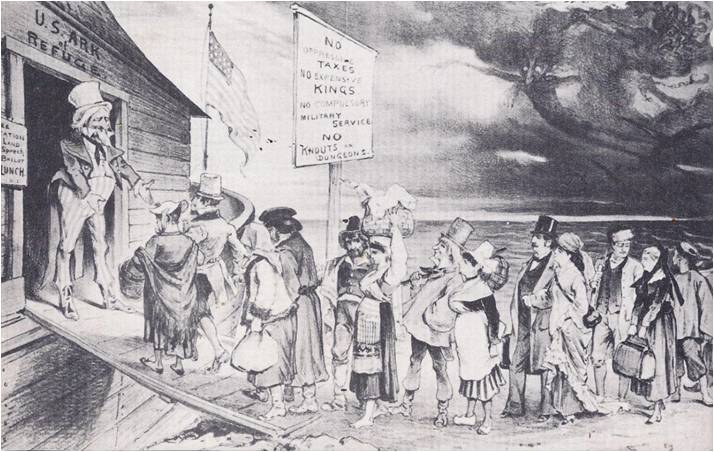
Even with the ever-increasing demand, the businessmen who made and sold goods would not have prospered as they did without the help of their friends and henchmen in government. Their products had to compete with products from other countries, especially Great Britain, which was often cheaper. To limit this competition, the national government put an import tax, or tariff, on manufactured goods coming into the country. This forced foreign manufacturers to raise their prices in the United States; to make a profit‚ they had to charge more for their wares than American manufacturers. As a result, sales of American goods went up and sales of foreign goods dropped.
Many Americans, especially farmers in the South, Middle West and West, would have preferred no tariff and cheaper foreign goods, but most Americans, including the increasing number of industrial workers, favoured the tariffs. The Republican party, which supported high tariffs won election after election over the Democratic party, which supported free trade. Except for a comparatively few years, the Republicans controlled the national government from the time of the Civil War until just before World War I.
While the government protected industry from foreign competition, it also encouraged industrialists to extend their operations westward. It offered huge tracts of land in the West to companies that would build railroads, dig mines, or cut down forests for timber. Like the tariff policy, the land-grant policy made it easier for business ventures to succeed by reducing their risks. A new railroad, for example, might carry little freight during its first years, but it could still make money by leasing the land it had acquired along its tracks to cattlemen or selling tracts of land to farmers. There was always a chance that the land might contain gold, silver, or other valuable minerals.
Not all of the business ventures were as successful as the transcontinental railroad. Some failed and others turned out to be frauds. There were gold mines that yielded nothing but rock dust and railroads that existed only in the imagination of the stockholders. More succeeded than failed and slowly the “Wild West” was tamed — to the profit of investors, most of them in the eastern states.
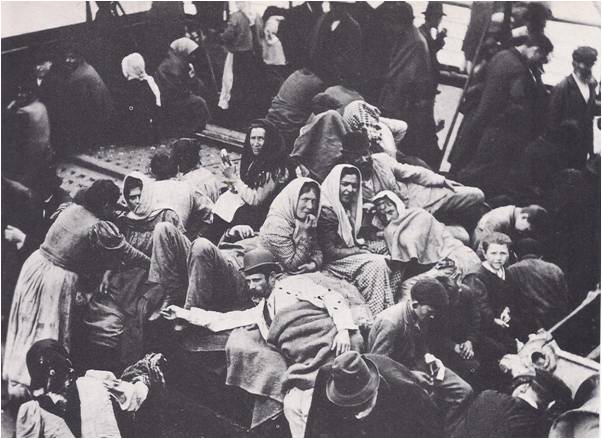
Meanwhile, settlers poured into the empty land. By 1912, when the admission of New Mexico and Arizona to the Union completed the pattern of states from coast to coast, the American West had thousands of miles of railroads. Towns and cities rose on the prairies and in the mountain valleys, on the shore of the Pacific and even on the desert. The value of the products sent east to market — minerals and timber, meat and hides, wool, grain and fruit — multiplied a thousand times.
As a matter of fact, all America grew after the Civil War. Between 1860 and 1910, the number of people increased from 30 million to 90 million, as ship after ship brought new arrivals from overseas. For industry needed men by the thousands and American firms sent agents to Europe to find workers. The Europeans were willing to listen. Like the Americans, the number of Europeans was increasing rapidly. Europe, too, was becoming industrialized — but only in the west and northwest. Within this area, industry created new jobs that kept pace with the growing population. Elsewhere, however, there were not enough jobs to go around and some Europeans were unemployed and hungry.
Other Europeans had different reasons for their discontent. Some disliked their rulers, or the form of government under which they lived. Some were poor but ambitious and they longed to escape from a land where there were few opportunities for anyone who did not belong to a rich or noble family. In America, anyone discontented with his lot could pack up and try his luck in the West; in Europe, there was no good land open to settlers. For Europeans, the only frontier was the Atlantic Ocean, beyond which lay America, the vast “land of opportunity.”
So thousands of Europeans listened eagerly to the agents and accepted their offer of a free trip across the ocean with a job waiting for them on the other side. Those who wanted to go to America and look for a job on their own could buy steamship tickets at low rates. One way or another, millions of Europeans emigrated to America. Some went to Latin America or Canada, but the vast majority went to the United States. They usually landed in New York, where, after 1886, they were greeted by the giant Statue of Liberty. Almost all of them were poor and they brought everything they owned with them, packed in trunks or boxes or simply wrapped in kerchiefs or pieces of cloth. After a short stay in the government receiving station on Ellis Island, they went ashore to discover the New World for themselves.
Often the newcomers were put to work at hard, heavy tasks that native-born Americans did not want. Many worked on construction gangs, erecting buildings and bridges and laying out roads and railways. The transcontinental railway, for instance, was mostly laid by Irishmen, working their way west from Missouri and Chinese, working east from California.
The vast westward flow of human beings, the greatest migration in history, began in the 1840’s, reached its peak in the first years of the twentieth century and did not die out until the 1920’s. The first waves of immigrants came from western and northern Europe, the later waves from eastern and southern Europe.
THE LAND OF OPPORTUNITY
In 1846, Ireland’s potato crop was ruined by a blight; to escape the terrible famine that followed, more than a million Irish people came to America. Most were poor peasants with little schooling. By contrast, there were many professional men and skilled mechanics among the Germans who began to arrive after the liberal revolution of 1848 was put down. Later, Danes, Swedes and Norwegians came, many of them settling on farms in the Middle West.
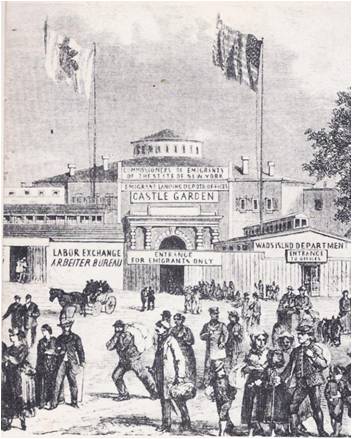
Beginning around 1890, most of the newcomers were from Poland which was then under the rule of Russia. Among them were large numbers of Jews, fleeing from persecution. Within a few years they were followed by thousands of Italians leaving behind the poverty and overcrowding of their native land.
During the decade, or ten-year period, of 1840-1850 the number of immigrants was a million and three-quarters. During each of the next three decades, arrivals averaged about two and a half million, rising to five and a quarter million between 1880 and 1890. In the last decade of the nineteenth century only three and three-quarter million persons arrived, but the first ten years of the twentieth century brought a record-breaking nine million men, women and children to the United States. Another ten million came between 1910 and the end of the 1920’s, when a law curbing immigration turned the flood of arrivals into a mere trickle.
Almost all the immigrants settled in the North, the Middle West and the West-that is, outside the southern states of the old Confederacy. While the great majority came from Europe, a small fraction came from China, Japan and another small fraction from Canada and Latin America. In Europe, most of the immigrants had lived on the land; in the United States, most found work in towns and cities where industry was established and stayed there. Meanwhile, more and more native-born Americans were leaving the farms to take jobs in factories, stores and offices and the cities grew rapidly.
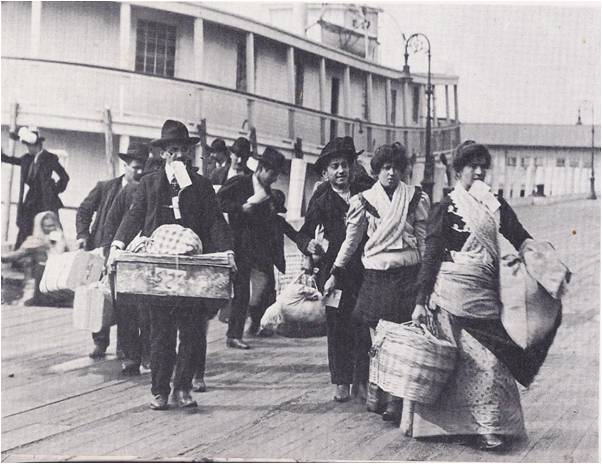
Between 1860 and 1910, the population of the country’s largest city, New York, increased from 1,750,000 to 4,750,000. Chicago grew from a city of about 50,000 to a metropolis with a million and a half inhabitants. Los Angeles, which had been no more than a village before the Civil War, became a city of half a million.
Even more significant was the rise in the proportion of city-dwellers to country-dwellers in the national population. In 1860, only one American in twelve lived in a town or city; by 1910, it was one in three. At the time of the Civil War, the United States was mainly a farming country, but during the next fifty years it became thoroughly industrialized. By the beginning of World War I, it was a great industrial power.





